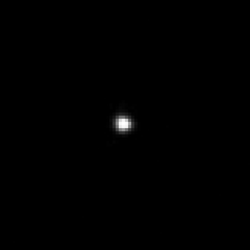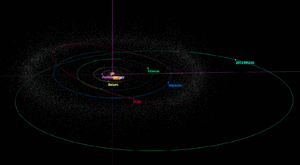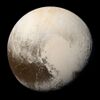Astronomy:(523794) 2015 RR245
 2015 RR245 imaged by the Hubble Space Telescope in October 2020 | |
| Discovery[3] | |
|---|---|
| Discovered by | OSSOS Michele T. Bannister et al.[1][2] |
| Discovery site | Mauna Kea Obs. |
| Discovery date | 9 September 2015 |
| Designations | |
| (523794) 2015 RR245 | |
| Minor planet category | TNO[4] · SDO · resonant (2:9)[2][5] p-DP[6] · distant[3] |
| Orbital characteristics[4] | |
| Epoch 27 April 2019 (JD 2458600.5) | |
| Uncertainty parameter 3 | |
| Observation arc | 13.10 yr (4,786 d) |
| Earliest precovery date | 15 October 2004 |
| |{{{apsis}}}|helion}} | 128.80 AU |
| |{{{apsis}}}|helion}} | 33.943 AU |
| 81.373 AU | |
| Eccentricity | 0.5829 |
| Orbital period | 734.05 yr (268,113 d) |
| Mean anomaly | 323.86° |
| Mean motion | 0° 0m 4.68s / day |
| Inclination | 7.5755° |
| Longitude of ascending node | 211.68° |
| |{{{apsis}}}|helion}} | ≈ 21 August 2092[7] ±3 days |
| 261.02° | |
| Physical characteristics | |
| Mean diameter | ≈500 km[5] ≈630 km[6] 500–870 km assuming a single object[2] |
| Geometric albedo | 0.12 (assumed)[2] 0.11 (assumed)[6] 0.135 (assumed)[5] |
| neutral G–R=0.59±0.11[2] | |
| Apparent magnitude | 21.2 (perihelic)[8] |
| Absolute magnitude (H) | 3.6±0.1 (Hr)[2] 4.01[3][4] 4.1[6] |
(523794) 2015 RR245, provisional designation 2015 RR245, is a large trans-Neptunian object of the Kuiper belt in the outermost regions of the Solar System. It was discovered on 9 September 2015, by the Outer Solar System Origins Survey at Mauna Kea Observatories on the Big island of Hawaii, in the United States.[3] The object is in a rare 2:9 resonance with Neptune and measures approximately 600 kilometers in diameter. 2015 RR245 was suspected to have a satellite according to a study announced by Noyelles et al. in a European Planetary Science Congress meeting in 2019.[9]
Discovery
A first precovery of 2015 RR245 was taken at the Cerro Tololo Observatory in Chile on 15 October 2004.[3][4] It was first observed by a research team led by Michele Bannister while poring over images that the Canada–France–Hawaii Telescope in Hawaii took in September 2015 as part of the Outer Solar System Origins Survey (OSSOS),[3][10][11] and later identified in images taken at Sloan Digital Sky Survey and Pan-STARRS between 2008 and 2016.[8] The discovery was formally announced in a Minor Planet Electronic Circular on 10 July 2016.[1]
Numbering and naming
This minor planet was numbered by the Minor Planet Center on 25 September 2018 (M.P.C. 111779).[12] As of 2021, it has not been named.[3]
Orbit and classification
As of 2018, 2015 RR245 has a reasonably well defined orbit with an uncertainty of 3. It orbits the Sun at a distance of 33.8–128.6 AU once every 731 years and 6 months (for reference, Neptune's orbit is at 30 AU). Its orbit has an eccentricity of 0.58 and an inclination of 8° with respect to the ecliptic.[4]
2015 RR245 is among the most distant known Solar System objects. As of 2018, it is 63 AU from the Sun. It will make its closest approach to the Sun in 2093, when it will reach an apparent magnitude of 21.2.[4][8]
2:9 resonance
Additional precovery astrometry from the Sloan Digital Sky Survey and the Pan-STARRS1 survey shows that 2015 RR245 is a resonant trans-Neptunian object, securely trapped in a 2:9 mean motion resonance with Neptune, meaning that this minor planet orbits the Sun twice in the same amount of time it takes Neptune to complete 9 orbits.[2] The object is unlikely to have been trapped in the 2:9 resonance for the age of Solar System. It is much more likely that it has been hopping between various resonances and got trapped in the 2:9 resonance in the last 100 million years.[2]
Physical characteristics
Diameter and albedo
Its exact size is uncertain, but the best estimate is around 670 km (420 mi) in diameter, assuming an albedo of 0.12 (within a wider range of 500 to 870 km, based on albedos of 0.21 to 0.07).[2] For comparison, Pluto, the largest object in the Kuiper belt, is about 2,374 km (1,475 mi) in diameter.[10][11] Astronomer Michael Brown assumes an albedo of 0.11 and calculates a diameter of 626 km,[6] while the Johnston's Archive gives a diameter of 500 kilometers for the primary and 275 km for the satellite, based on an assumed equal albedo of 0.135.[5]
Possible satellite
2015 RR245 is suspected to be binary.[13] If this moon exists and significantly contributes to the observed brightness of the primary, the size of 2015 RR245 may therefore be substantially smaller than estimates that assumed the system's total brightness was from a single object; the system may be similar to that of 174567 Varda. Once the orbit of the satellite is determined, the mass and density of the 2015 RR245 can be determined.[9][14] 2015 RR245 was observed by the Hubble Space Telescope in 2020, but did not detect the putative satellite.[13]
References
- ↑ 1.0 1.1 Tomatic, A. U. (10 July 2016). "MPEC 2016-N67 : 2015 RR245". Minor Planet Electronic Circular (Minor Planet Center) 2016-N67. Bibcode: 2016MPEC....N...67B. https://www.minorplanetcenter.net/mpec/K16/K16N67.html.
- ↑ 2.0 2.1 2.2 2.3 2.4 2.5 2.6 2.7 2.8 Bannister, Michele T.; Alexandersen, Mike; Benecchi, Susan D.; Chen, Ying-Tung; Delsanti, Audrey; Fraser, Wesley C. et al. (December 2016). "OSSOS. IV. Discovery of a Dwarf Planet Candidate in the 9:2 Resonance with Neptune". The Astronomical Journal 152 (6): 8. doi:10.3847/0004-6256/152/6/212. Bibcode: 2016AJ....152..212B.
- ↑ 3.0 3.1 3.2 3.3 3.4 3.5 3.6 "523794 (2015 RR245)". Minor Planet Center. https://www.minorplanetcenter.net/db_search/show_object?object_id=523794. Retrieved 12 December 2020.
- ↑ 4.0 4.1 4.2 4.3 4.4 4.5 "JPL Small-Body Database Browser: 523794 (2015 RR245)". Jet Propulsion Laboratory. https://ssd.jpl.nasa.gov/sbdb.cgi?sstr=2523794. Retrieved 9 October 2018.
- ↑ 5.0 5.1 5.2 5.3 "List of Known Trans-Neptunian Objects". Johnston's Archive. 23 July 2023. http://www.johnstonsarchive.net/astro/tnoslist.html. Retrieved 31 July 2023.
- ↑ 6.0 6.1 6.2 6.3 6.4 Michael E. Brown. "How many dwarf planets are there in the outer solar system? (updates daily)". California Institute of Technology. http://web.gps.caltech.edu/~mbrown/dps.html. Retrieved 13 September 2019.
- ↑ "Horizons Batch for 523794 (2015 RR245) on 2092-Aug-21". JPL Horizons. https://ssd.jpl.nasa.gov/api/horizons.api?format=text&COMMAND=%27523794%27&START_TIME=%272092-Aug-01%27&STOP_TIME=%272092-Aug-31%27&STEP_SIZE=%273%20hours%27&QUANTITIES=%2719%27. Retrieved 2023-08-27. (JPL#21/Soln.date: 2023-Feb-09)
- ↑ 8.0 8.1 8.2 Weryk, R.J.; Lilly, E.; Chastel, S.; Denneau, L.; Jedicke, R.; Magnier, E.; Wainscoat, R.J.; Chambers, K.; Flewelling, H.; Huber, M.E.; Waters, C. (17 July 2016). "Distant Solar System Objects identified in the Pan-STARRS1 survey". arXiv:1607.04895 [astro-ph.EP].
- ↑ 9.0 9.1 Noyelles, Benoît; Hestroffer, Daniel; Petit, Jean-Marc (September 2019). "Orbital solutions for the OSSOS binaries". EPSC-DPS Joint Meeting 2019. 13. European Planetary Science Congress. Bibcode: 2019EPSC...13..601N. https://meetingorganizer.copernicus.org/EPSC-DPS2019/EPSC-DPS2019-601-1.pdf.
- ↑ 10.0 10.1 "New Dwarf Planet Discovered Far Beyond Pluto's Orbit". space.com. 11 July 2016. http://www.space.com/33387-dwarf-planet-discovery-2015-rr245.html.
- ↑ 11.0 11.1 Chang, Kenneth (13 July 2016). "Astronomers Discover New Likely Dwarf Planet, the Latest of Many". The New York Times. https://www.nytimes.com/2016/07/14/science/astronomers-discover-new-likely-dwarf-planet.html. Retrieved 14 July 2016.
- ↑ "MPC/MPO/MPS Archive". Minor Planet Center. https://www.minorplanetcenter.net/iau/ECS/MPCArchive/MPCArchive_TBL.html. Retrieved 9 October 2018.
- ↑ 13.0 13.1 Fraser, Wesley. "Confirming the binarity of Kuiper Belt Object 2015 RR245: a test of the streaming instability HST Proposal 16167". Mikulski Archive for Space Telescopes. Space Telescope Science Institute. https://archive.stsci.edu/proposal_search.php?id=16167&mission=hst. Retrieved 3 June 2020.
- ↑ "Confirmation of the discovery of a moon around 2015 RR245". Gemini Observatory. August 2019. https://www.gemini.edu/files/fast/df6ea262b6.pdf. Retrieved 16 January 2020.
External links
- MPEC 2016-N67 : 2015 RR245, Minor Planet Electronic Circular – Minor Planet Center
- New Dwarf Planet, Canada–France–Hawaii Telescope
- Kuiper Belt's Big, New, Far-Out Object, Sky & Telescope
- Outer Solar System Origins Survey (OSSOS)
- New Dwarf Planet Discovered Beyond Neptune on YouTube (time 1:01 min.)
- Discovery announcement
- (523794) 2015 RR245 at AstDyS-2, Asteroids—Dynamic Site
- (523794) 2015 RR245 at the JPL Small-Body Database
 |





